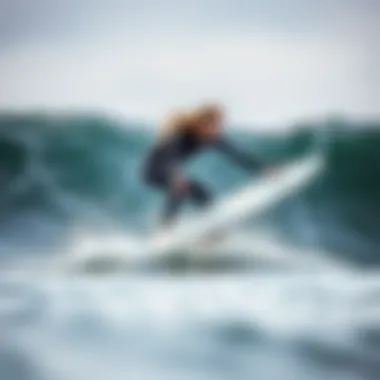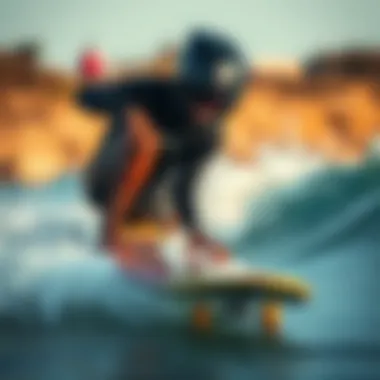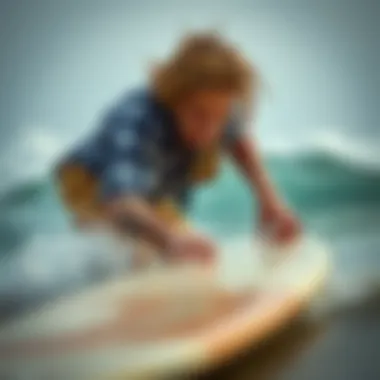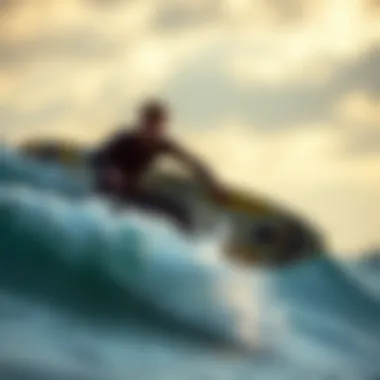Mastering Longboard Carving Techniques and Safety Tips


Intro
Longboard carving invites riders into a world where grace meets precision, combining the thrill of speed with the enjoyment of fluid movements. Understanding this art form isn't just about balance; it’s a deep dive into the techniques, gear, and biomechanics that define a smooth ride. As you navigate this informative journey, we’ll unpack the skills essential for mastering carving, the equipment that enhances your experience, and the safety measures invisible yet fundamental to every longboard enthusiast. Through practical advice and insights gathered from seasoned riders, this guide aims to empower enthusiasts from all levels to elevate their carving technique to new heights.
Surfing Techniques
Beginner Tips for Getting Started
For those just stepping into the captivating world of longboarding, mastering the fundamentals is key to building confidence on the board. It’s crucial to learn how to shift your weight effectively. Leaning into the turns rather than just rotating your hips can significantly improve your carving technique. Here are a few practical tips to help you hit the ground rolling:
- Start Slow: Begin your journey on flat terrain before tackling inclines. This will give you time to develop your balance.
- Foot Placement: Position your back foot behind the rear trucks to exert more control during turns. Your front foot should remain near the center, guiding the board smoothly.
- Body Movement: Use your arms for balance. Extending your arms helps maintain stability, especially during sharp turns.
- Practice Carving: Find some gentle hills, and practice S-turns. This not only builds confidence but also helps in understanding the dynamics of your board.
These tips provide a solid foundation, steering you away from the common pitfalls beginners often face.
Advanced Maneuvers and Tricks
Once you feel comfortable with the basics, it’s time to spice things up a notch. Advanced carving techniques can take your skills from novice to pro in no time. Learning how to pump your board, for instance, allows you to generate speed without pushing. Here's how to advance your skills:
- Cross-Stepping: Shift your weight forward and backward while stepping across the board, providing better control and style.
- Sliding: For practice, try the Coleman slide or the Standup slide. They help in learning how to manage speed and maintain balance while correcting your trajectory on steeper paths.
- Utilize the Curb: Riding along a curb or wall can teach you how to manage angles and turns effectively.
Complex techniques might appear daunting, yet with patience and practice, they can become part of your carving repertoire, allowing for more creative riding.
"Carving is about staying connected with the board and the ground; it’s a dance between maintaining speed and controlling direction."
As you refine your skills and add flair through tricks, your confidence will grow, paving the way for endless possibilities on longboard.
Equipment Selection
Choosing the Right Board for Your Style
Selecting the ideal longboard involves more than just aesthetics; it’s about matching the board's specifications with your riding style. Consider the following:
- Shape: A drop-through longboard can provide better stability for downhill rides, while a pintail is excellent for cruising.
- Length and Width: Longer boards offer smoother rides, while shorter boards allow for quick turns. Choose based on your comfort level.
- Wheels: Softer wheels provide better grip and comfort, perfect for cruising, while harder wheels are better suited for speed and sliding.
These elements contribute significantly to how a board performs and how well you can carve.
Board Maintenance and Care
Once you've found your trusty longboard, it’s essential to keep it in prime condition:
- Regular Inspections: Check for any damage, such as cracks or wear in the wheels that might affect performance.
- Cleanliness: Keeping the wheels and trucks free from dirt and debris ensures longevity and maximum performance.
- Loosen or Tighten Trucks: Adjusting the trucks according to your riding style can make or break your carving experience. A tighter truck helps with stability, while looser setups enhance maneuverability.
Investing time in upkeep not only extends the lifespan of your board but enhances your riding experience, ensuring that every carve is precise and enjoyable.
Understanding Longboarding
Longboarding is more than just a mode of transport; it embodies a lifestyle of freedom and self-expression. Understanding longboarding forms the foundation of becoming proficient, particularly in the skill of carving. Carving is not merely about maneuvering a board; it is an intricate dance of balance, weight transfer, and rhythm.
The essence of longboarding lies in its simplicity and the sheer joy it brings. It's a pathway to exploring urban landscapes, picturesque trails, and scenic hillsides. For those who seek thrills and the exhilaration of gliding on pavement, understanding the nuances of longboarding can enhance the entire experience. By grasping the fundamentals, enthusiasts can appreciate how the ride transforms as they develop skills. Every push, every turn, every carve adds to the mastery of the board.
Defining Longboard Carving
Carving on a longboard involves executing smooth, rhythmic turns. Unlike skating, which often leans towards tricks and jumping, carving invites you to engage with your environment more fluidly. Picture yourself gliding down a winding road, leaning into each turn, harnessing gravity to propel you forward. The way you move your body directly influences how the board responds.
Proper carving technique requires a sound understanding of body positioning and weight distribution. Key elements include:
- Lean: The manner in which a rider tilts their body into the turn.
- Pressure: Shifting weight to initiate and maintain the carve.
- Balance: Using core strength to stay centered over the board without wobbling.
This dance with the board brings out a sense of harmony between rider and machine.
Historical Context of Longboarding
Longboarding has its roots deeply embedded in surfing culture, emerging in the late 1950s and early 1960s. Surfers sought a way to replicate the feel of riding waves on land, leading to the creation of the longboard. The longboard offered a more stable platform than traditional skateboards, making it easier to carve and glide.
Over time, longboarding evolved into diverse styles such as cruising, downhill racing, and freestyle. Each style draws from various influences, creating a rich tapestry of techniques, shapes, and community cultures. The significance of longboarding also reflects broader societal shifts, becoming a symbol of various youth movements over decades.
Now, longboarding is globally recognized, with various communities forming around it. Riders share tips, experiences, and tricks both online and offline, reinforcing the culture and sense of belonging. The journey of longboarding, from its humble beginnings to its status as a niche sport, showcases both its historical and cultural significance.
"In a world where everything moves too fast, longboarding slows down time and brings you back to feeling alive."
Understanding these elements not only enriches the experience of longboarding but sets the stage for mastering the art of carving.
Essential Components for Carving
Understanding the essential components for carving is vital for anyone aspiring to master longboard carving. Each component plays a unique role that can make or break your experience on the board. Whether you are a novice or a seasoned rider looking to polish your skills, having the right gear is non-negotiable. Not all longboards are created equal, and choosing components that cater specifically to carving can significantly enhance your performance and safety. This section will break down the core elements you need to consider for effective carving: the longboard itself, the wheels and trucks that support your ride, and the flexibility of your setup.
Choosing the Right Longboard


Choosing the right longboard sets the stage for a successful carving experience. Your board's shape, wheels, and flexibility all contribute to how well you can execute those graceful turns.
Board Shape
The board shape plays a crucial role in carving. You’ll often find longboards shaped like pintails or drop-through boards common among carvers. Pintails offer a classic elongated design that aids in smooth turns, especially on flat surfaces. Alternatively, drop-through boards get their name from the way the trucks are mounted on top of the board, lowering the center of gravity and providing better stability, which is a boon for initiating turns.
A key characteristic of board shape is its length and width. Longer boards tend to provide better stability at high speeds, while wider boards allow for more foot placement options, giving you greater control during your ride. This can be particularly beneficial for someone looking to improve their carving technique while maintaining their balance effectively.
However, it's also important to note that a longer, wider board might be challenging for tight turns in proximity. Thus, careful consideration of your carving preference will guide you to a suitable board shape that complements your style.
Wheels and Trucks
Moving on to wheels and trucks, these components are the unsung heroes in your carving setup. The wheels must be soft enough to absorb shocks from rough terrain, allowing for smoother rides and better grip during turns. A common consideration is the durometer, or hardness, of the wheels. Softer wheels (78A to 83A) provide that cushioned feel over bumps, but they may wear out faster on smooth surfaces.
Trucks, on the other hand, not only secure your wheels but also determine how your board responds to turns. A key characteristic of a good carving truck is its ability to lean. When trucks are designed with a wider base, they offer stability, while those with a narrower profile provide better turning responsiveness. The choice may come down to your personal style of carving.
"The right trucks can make all the difference in your ability to connect your turns fluidly."
While a well-paired set of wheels and trucks greatly enhances your control and maneuverability, mismatching them can lead to an unstable ride or premature wear.
Flexibility
Finally, flexibility in your longboard offers a dimension of performance that is often overlooked. A flexible board can absorb vibrations much better than a stiff board, making it ideal for rough terrains while allowing for more energy transfer during turns. This flexibility results in a smoother ride overall, letting you connect your carves seamlessly.
The unique aspect of flexibility is the various degrees available. Some boards are designed to be stiffer for those who prefer precise carving at high speeds and don’t want any unwanted wobble. Conversely, more flexible boards are popular among riders who appreciate a more relaxed feel and enjoy performing tricks alongside their carving.
Nevertheless, the amount of flex can also influence your stability. A high-flex board could make advanced carving more enjoyable but might compromise on stability for a beginner still finding their bearings.
Safety Gear Essentials
Safety gear is non-negotiable in longboarding, especially when it comes to carving. Not only does proper gear protect you physically, but it can also enhance your confidence, allowing you to carve without the constant worry of accidents.
Helmet
The helmet is perhaps the most critical piece of gear you can own. It protects your head during falls, which are almost inevitable, especially when you are learning. A well-ventilated, snug-fitting helmet meets safety standards, ensuring maximum protection without sacrificing comfort.
A significant factor about choosing a helmet is the material used. Most reputable helmets utilize expanded polystyrene (EPS) foam for shock absorption. A unique feature of some models includes additional padding for fit customization, making them even safer. However, opting for cheaper helmets can sometimes lead to inadequate protection, literally putting you in a compromising position when you take a tumble.
Knee and Elbow Pads
Knee and elbow pads are your next line of defense. They add an extra layer of protection, absorbing impact when you fall. Look for pads with breathable material, ensuring that you stay comfortable while wearing them for long periods. When selecting pads, choose those that provide a snug fit without being overly constrictive, allowing for a range of motion necessary for carving.
While these pads are essential, their bulkiness may deter some riders from using them. Ultimately, it’s about balancing comfort with safety.
Proper Footwear
Last but not least, the importance of proper footwear cannot be stressed enough. The right shoes provide the grip necessary to maintain control over your board, especially during intense carving sessions. Skate shoes with flat soles and a good grip give you the edge, allowing for better foot placement and maneuverability.
Consider features like breathability and flexibility in your choice. Some riders prefer shoes that are a bit more rigid, giving them that added support needed for technical moves. On top of it all, the right footwear creates a connection between you and your board, allowing for better responsiveness and control during your carving sessions.
Basic Carving Techniques
The world of longboard carving is not just a thrilling pastime but also an intricate dance between physics and technique. Mastering the basic carving techniques is crucial for anyone wanting to harness the full potential of their longboard. These foundational skills act like the solid ground beneath your feet, providing stability and control as you glide through twists and turns. If you want to explore the exhilarating feel of carving down your favorite hill, getting the basics down is the first step.
Understanding Weight Distribution
Weight distribution plays a vital role in carving for longboarders. It essentially dictates how the board reacts under your feet. When carving, shifting your weight to your toes or heels helps initiate turns. Beginners often struggle with this; they might lean back or stay flat, which can lead to wobbling or, worse, a nasty spill.
To get comfortable, practice adjusting your stance. Start by standing still on your board, shifting your weight back and forth. This isn't just mindless fidgeting; it lays the groundwork for more dynamic movements when you're on the move. Think of your weight as a pendulum. As it shifts, so should your board respond. This careful balance not only aids in steering; it maximizes your control as you carve through curves.
Initiating the Carve
Once you've got the hang of weight distribution, the next step is initiating the carve. This is where finesse and confidence come into play. To kick things off, it’s vital to begin at a gradual speed. You don’t want to take on steep hills right away—this is a recipe for disaster.
Here’s how you can initiate a carve effectively:
- Start by maintaining a slight bend in your knees. This will help you absorb shocks and maintain balance.
- As you approach a turn, lean slightly in the direction you want to go. Your torso should follow your legs as you guide the board.
- Simultaneously transfer your weight to your toes or heels, depending on the turn. You should feel the board begin to lean into the curve.
Think of initiating a carve like steering a car. You don’t just jerk the wheel; it’s a fluid motion that requires both intention and delicacy.
Maintaining Momentum
There’s nothing worse than gearing up for a sweet carve only to find yourself losing speed halfway through. Maintaining momentum is key to linking your carving moves smoothly. The flow from one turn to the next creates that seamless riding experience that seasoned longboarders thrive on.
To keep that speed up:
- Stay low. The lower your center of gravity, the more stable you'll be. Bend your knees and keep a wide stance.
- Use your arms strategically. They are more than just flailing appendages; your arms can help steer and maintain balance. As you carve, open your arms out to stabilize your body.
- Pumping the board is also a technique many find useful. As you exit a turn, push down and lift slightly with your back foot to gain extra speed.


"Momentum isn’t just about speed; it’s about the rhythm you create on your longboard."
In seeking out challenges in your carving journey, don’t rush. Challenge yourself incrementally, pushing against the edges of your comfort zone with each ride. Whether you glide through empty parking lots or navigate hilly streets, mastering these basic techniques sets the stage for more advanced skills down the line. Every longboarding journey is unique, and these foundational elements offer a reliable framework for your adventures.
Advanced Carving Techniques
Mastering advanced carving techniques is crucial for longboarders who want to take their skills to the next level. Engaging in deeper, more nuanced carving not only enhances the aesthetic appeal of the ride but also fosters greater control and precision. These techniques allow riders to express their individuality while navigating varying terrains. Focusing on deep carving, incline carving, and combining tricks with carving, each of these elements brings fresh challenges and opportunities to enhance one's overall longboarding experience.
Deep Carving
Deep carving is a technique that involves leaning into the turns more dramatically than in basic carving. This method utilizes a deeper angle to increase speed and control while maintaining a smooth ride. To execute a deep carve, the rider needs to shift their weight significantly onto the edge of the board, which engages the trucks more effectively.
Benefits of Deep Carving:
- Increased Speed: The deeper edge allows for sharper turns without losing velocity.
- Enhanced Control: Riders can better navigate obstacles and corners, providing a stable ride.
- Aesthetic Flow: Deep carves look beautiful. Riders often appear more fluid and graceful.
In essence, practicing deep carving helps develop balance and body awareness on the board. Riders must be attentive about their stance and weight distribution to maintain equilibrium throughout the carving motion.
Carving on Inclines
Carving on inclines presents a unique set of challenges and pleasures. When riding downhill, the dynamics change dramatically as gravity plays a significant role. Riders can harness the speed generated by downhill slopes to make sweeping turns that feel like flying.
Considerations for Carving on Inclines:
- Speed Management: It’s essential to control the descent. Use your body to lean back slightly to stabilize your speed.
- Foot Placement: Your foot placement will impact control. Keeping your toes closer to the nose of the board can help with initiating faster turns.
- Terrain Awareness: Always check for potential hazards like rocks or debris.
Mastering this element often requires practice and a keen awareness of the hill's varying slope. Riders often find that their confidence grows significantly after achieving proficiency in this technique, opening doors to more complex maneuvers.
Combining Tricks with Carving
When riders start to feel comfortable with their carving ability, experimenting with combining tricks adds an exhilarating layer to the experience. Tricks such as slides, ollies, or shuvits can be seamlessly integrated with carving to elevate one's performance.
Creating a Cohesive Style:
- Trick Alignment: Ensure that the tricks you are attempting complement your carving technique. For instance, practicing a slide can enhance your understanding of weight distribution as you shift during the carve.
- Fluid Transitions: Aim to make transitions between tricks and carving as smooth as possible. This allows for a polished style that captivates onlookers.
- Practice Variations: Don’t shy away from experimenting with different tricks while carving, as this can yield unique styles and techniques.
"Proper practice with deep carving and incline techniques can turn a casual rider into a true longboarding maestro."
By continually refining these skills, longboarders will not only develop their technique but will also contribute to their longboarding community, sharing experiences and knowledge along the way. For those keen on exploring these aspects of longboarding further, joining local groups or engaging in online discussions can be beneficial.
Biomechanics of Carving
Understanding the biomechanics of carving is crucial for anyone serious about longboarding. This knowledge not only influences the performance but also enhances safety while carving through turns and slopes. By dissecting the science behind how your body moves, you cultivate a deeper connection to your board, allowing for more expressive and fluid motions as you carve.
The Role of Body Position
Body position plays a pivotal role in how effectively you carve. When you're on your longboard, your posture can either make or break your experience. Proper alignment helps distribute your weight, enabling smoother transitions and allowing for greater control.
Consider a few key details regarding body position:
- Feet Placement: Your feet should sit shoulder-width apart, with the front foot angled slightly forward and the back foot parallel to the board. This setup gives you balance and better control when initiating a turn.
- Knees Bent: Keep your knees slightly bent. This flexibility not only absorbs bumps in the road but also allows for a quicker reaction to changes in terrain.
- Upper Body Alignment: Your arms should be relaxed by your sides or slightly out as if you are extending wings. This natural positioning allows for easier weight shifts and pivots.
When you carve, leaning into the turn is important, and how far you lean will depend on the speed and angle of the turn. Too much lean might send you tumbling, while too little can lead to sluggish turns.
"Proper body positioning is like the foundation of a house; if it’s not solid, everything else is at risk of coming crumbling down."
Your Core's Influence on Control
The core muscles are the unsung heroes of longboard carving. They act as your body's powerhouse, anchoring your movements and helping in balance. When your core is engaged, it stabilizes your body, allowing for finer control over your turns.
Here are several ways your core aids in carving:
- Stability: A strong core provides a stable base, easing the transition during carving. It mitigates unnecessary upper body movements that can lead to losing control.
- Weight Transfer: Efficient weight transfer during a carve depends on how well your core engages. It helps in directing your mass to achieve seamless movements.
- Quick Reactions: If you hit an unforeseen bump or curve, your core enables quicker adjustments, ensuring you maintain balance.
To strengthen your core for better carving:
- Incorporate exercises like planks, sit-ups, and balance drills into your routine.
- Practice your carving using controlled environments before taking on steeper challenges.
- Focus on breath control while performing carving maneuvers—this keeps your movements smooth.
As you hone these biomechanics, you’ll find that carving is not just a skill; it becomes an art form that connects you with both board and bold motion.
Environmental Considerations
Environmental factors play a critical role in longboard carving, significantly influencing not just the rider’s performance but also the overall experience. Riders need to be mindful of their surroundings to maximize both safety and enjoyment. Choosing the right environment for carving can enhance the ride, allowing for smoother transitions, confident turns, and a greater connection to the surface below. Let's examine how various surface types and the surrounding traffic can either support or challenge your longboarding endeavors.
Selecting Suitable Locations
Surface Type


The surface type on which you carve can make all the difference. Smooth asphalt or concrete provides a gratifying experience, as it allows for effortless gliding and quick changes in direction. The key characteristic of a well-maintained roadway is its flatness, which can minimize the chances of falls and mishaps. A clean, smooth surface reduces friction, allowing the longboard wheels to roll freely and encourages seamless carving.
Among common choices, asphalt roads are often favored due to their smooth finish and durability. However, one must be vigilant about cracks, potholes, and debris that can cause instability and possible accidents. On the other side of the spectrum, cobblestone or gravel paths present significant challenges. The unevenness poses a risk of wobbling, making it tricky for beginners or advanced riders to maintain control. Ultimately, selecting a surface is not just about comfort; it also affects your carving style and technique, shaping how you interact with your board.
Traffic and Safety
Traffic and safety considerations go hand in hand when choosing a longboarding location. The presence of vehicles can introduce hazards that can spoil an otherwise enjoyable run. The main characteristic that stands out in this area is the availability of car-free zones or areas with low vehicle density. Finding quieter streets, parks, or designated pathways makes a substantial difference, allowing for an uninterrupted flow while carving.
Notably, riding in locations with minimal traffic not only enhances safety but also boosts confidence, giving riders the mental space to focus on their techniques without the anxiety of speeding cars around them. However, the converse is also true; busy roads filled with vehicles can turn even the most seasoned rider's experience into a stressful encounter. Choosing the right location with ample space and limited traffic congestion can pave the way for a more relaxed and enjoyable ride.
Understanding Weather Conditions
The weather can significantly influence your longboarding experience. Riding under sunny skies can be fantastic, with dry conditions allowing for maximum grip. However, rain or wet surfaces can be treacherous. Wet roads lead to reduced traction, making it difficult to control your longboard, especially during sharp turns. Hence, keeping an eye on weather forecasts and understanding local climate patterns can help longboarders plan their outings more effectively.
Whether you are chasing perfect carving conditions on sun-drenched pavements or avoiding the challenges of damp surfaces, being conscientious of your environment ensures not just a better ride but also contributes to your safety and enjoyment. Always remember, a thoughtful rider is a smart rider!
Common Challenges in Carving
Engaging in longboard carving presents enthusiasts with a wealth of techniques, often accompanied by numerous hurdles. While the allure of carving might seem irresistible, various challenges lurk in the making. Understanding these obstacles is crucial not only for enhancing one’s skills but also for fostering a genuine appreciation for the art itself. In this section, we’ll dissect these common challenges surrounding carving, focusing on key elements such as the psychological components, physical aspects, and methodologies for overcoming them.
Identifying and Overcoming Fear
Fear is a formidable barrier for many longboarders, particularly those venturing into the world of carving for the first time. The sensation of racing downhill or executing a sharp turn can ignite a primal instinct to brace oneself, often leading to hesitation. It’s important to recognize that fear, while a natural emotion, can be managed.
Here are a few effective strategies to confront that fear:
- Gradual Exposure: Start on gently sloping terrains where you feel comfortable. As confidence builds, progress to steeper inclines or more challenging surfaces.
- Visualization Techniques: Picture yourself performing the carve successfully. This mental preparation can reduce anxiety and improve performance.
- Positive Reinforcement: Celebrate small victories. Each successful run adds a layer of confidence, proving to yourself that progression is achievable.
A proactive approach to overcoming fear can open doors to smoother, more exhilarating carving experiences. Embrace the challenge, persist, and soon you’ll find fear transforming into thrill.
Learning from Falls
Every longboarder's path is peppered with falls. Whether due to miscalculating a turn or hitting an unexpected bump, falling is part of the journey. However, treating each tumble as a learning opportunity can be revolutionary.
When you take a spill, ask yourself:
- What went wrong? Reflect on the circumstances leading to the fall. Was it a lapse in focus or insufficient skill level?
- What can I change? Consider adjustments in technique, body positioning, or even board setup. Sometimes, a slight tweak can make a world of difference.
- Am I properly equipped? Ensure that your gear is right for your skill level and style. An improper setup can lead to unnecessary falls.
Falling teaches resilience. Instead of shying away from it, embrace the lessons embedded in every experience. Each fall brings you one step closer to mastering your craft.
Important Note: Maintaining a mindset of growth and adaptability will not only enhance your skills but also your enjoyment of longboard carving.
By understanding and tackling these challenges, longboard carving can transform not just into a skill but also into an art form, allowing each rider to navigate with grace and confidence.
Longboarding Community and Resources
The longboarding community forms the very backbone of this exhilarating sport. Engaging with others who share a passion for carving can enrich your experience beyond measure. It's not just about riding a board; it's a lifestyle characterized by camaraderie, support, and shared learning. When you dive into longboarding, understanding the community resources can be just as crucial as honing your carving skills.
First off, local groups and clubs often provide invaluable opportunities for learning and growth. They can help you navigate various environments and terrains, making the mastering of each turn and slide feel less daunting. Beyond improving your technical skills, these local connections foster friendships that can last a lifetime. When you connect with others, you open doors to organized events and meet-ups where experiences are shared, and tips are exchanged.
Participating in community events also enhances your confidence. Being around other riders helps normalize the challenges that come with learning, allowing you to realize that you're not alone in your journey. The collective knowledge available in these groups can sometimes be the best learning tool, as you get to see and feel techniques in person rather than just through videos.
Connecting with Local Groups
Finding local longboarding groups can feel like striking gold. Meetup.com, Facebook groups, and even your local skate shops are all great places to start. Many areas have community events that cater specifically to longboard enthusiasts. Here, you can literally rub elbows with riders of all levels, from seasoned pros to eager beginners.
Once you find a group, it’s beneficial to participate actively. You might join group rides or attend local competitions, which are both excellent ways to learn new skills and get feedback on your technique. Moreover, the encouragement from fellow riders during these activities can significantly bolster your motivation. Some local groups even offer workshops that focus on honing specific skills like carving or downhill riding.
Online Forums and Educational Content
The digital realm is ripe with resources for longboarders who seek to elevate their skills. Online forums like reddit.com/r/longboarding offer a treasure trove of information, ranging from beginner tips to advanced carving techniques. You can ask questions, share experiences, and troubleshoot issues with mechanics or gear in real-time with fellow longboard enthusiasts who have been there, done that.
In addition to forums, educational content on platforms like YouTube provides visual instruction that's hard to beat. Watching established longboarders demonstrate carving techniques can illuminate nuances that are difficult to grasp simply through text. These tutorials often come with comment sections filled with insights from viewers who share their own experiences, constantly feeding a growing pool of knowledge.
Furthermore, many riders document their journeys through blogs and personal websites, detailing everything from gear reviews to their favorite riding spots. Websites like longboarderlabs.com or skatewarehouse.com offer comprehensive guides, detailed product reviews, and essential riding techniques catered specifically to longboard carving.
Engaging with both local and online communities offers a wealth of learning opportunities. Whether you gain tips from a local veteran or absorb information from an online expert, each interaction strengthens your understanding and abilities in the art of longboarding.
Ultimately, being part of the longboarding community, whether in-person or online, means contributing to and drawing from a rich culture where shared enthusiasm thrives. Engaging with resources available through connections can turn a simple hobby into a lifelong passion.
End
Reflecting on the journey of mastering longboard carving is crucial for anyone who wishes to develop their skills in this thrilling sport. By emphasizing a few key elements, we'll uncover the intricate relationship between personal growth and technical proficiency in longboarding. The beauty of this sport is not just about the act of carving itself but also about the mindset it cultivates.
Personal Growth: Each carving session not only hones your technical abilities but also challenges your mental fortitude. You learn to conquer fears and push limits, which is key in both skating and life. Every fall teaches resilience, reminding you that setbacks often lead to greater insight and improvement. Understanding this cyclical journey of learning helps carve deeper into your personal growth.
Technical Proficiency: As you navigate through basic to advanced techniques, you begin to blend your knowledge with your own style. Experimenting with deep carving, maneuvering on inclines, or even integrating tricks enriches your carving repertoire. This technical journey reflects a unique artistry that develops with practice.
"Longboarding is not just about the ride; it’s about finding your flow and rhythm."
Community Connections: Mastery doesn’t happen in a void; it thrives within a community. Engaging with local riders or online forums creates an ecosystem of support and learning. You share experiences, swap tips, and celebrate victories—big and small.
In summary, the conclusion of this exploration is a reminder that longboard carving is not merely a physical activity but a profound journey that encompasses skill, resilience, and the spirit of community. Recognizing this can propel an enthusiast from a beginner in carving to a confident practitioner, relishing every twist and turn along the way.



